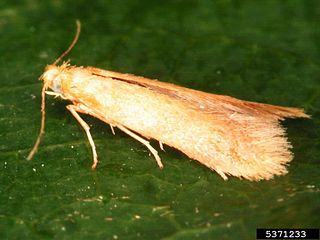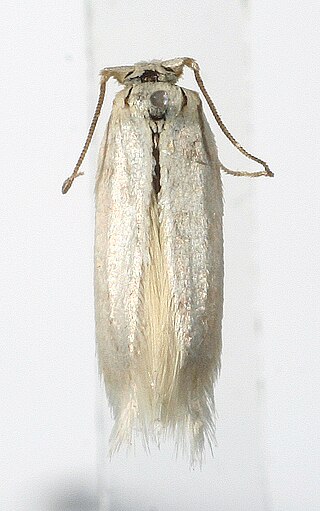
The Ditrysia are a natural group or clade of insects in the lepidopteran order containing both butterflies and moths. They are so named because the female has two distinct sexual openings: one for mating, and the other for laying eggs.

Macrolepidoptera is a group within the insect order Lepidoptera. Traditionally used for the larger butterflies and moths as opposed to the "microlepidoptera", this group is artificial. However, it seems that by moving some taxa about, a monophyletic macrolepidoptera can be easily achieved. The two superfamilies Geometroidea and Noctuoidea account for roughly one-quarter of all known Lepidoptera.

Riodinidae is the family of metalmark butterflies. The common name "metalmarks" refers to the small, metallic-looking spots commonly found on their wings. The 1,532 species are placed in 146 genera. Although mostly Neotropical in distribution, the family is also represented both in the Nearctic, Palearctic, Australasian (Dicallaneura), Afrotropic, and Indomalayan realms.
The Prodoxidae are a family of moths, generally small in size and nondescript in appearance. They include species of moderate pest status, such as the currant shoot borer, and others of considerable ecological and evolutionary interest, such as various species of "yucca moths".

Nepticuloidea is a superfamily of usually very small monotrysian moths that are characterised by small or large eyecaps over the compound eyes. It comprises two families, the "pigmy moths" (Nepticulidae), with 12 genera which are very diverse worldwide and are usually leaf miners, and the "white eyecap moths" (Opostegidae), also worldwide but with five genera and about a ninth as many species, whose biology is less well known.

Adeloidea is a superfamily of primitive monotrysian moths in the order Lepidoptera which consists of leafcutters, yucca moths and relatives. This superfamily is characterised by a piercing, extensible ovipositor used for laying eggs in plants. Many species are day-flying with metallic patterns.
Palaephatoidea is a superfamily of insects in the order Lepidoptera with a single family, Palaephatidae with seven known genera. These "Gondwanaland moths" exhibit a disjunct distribution occurring mainly in South America, with four species in eastern Australia and Tasmania and one in South Africa. The larvae spin together leaves of Proteaceae (Ptyssoptera) or Verbenaceae (Azaleodes) . Palaephatoidea, a typical monotrysian group, is one two main candidates as the sister group of most of the Lepidoptera, the Ditrysia.

Tischerioidea is the superfamily of "trumpet" leaf miner moths. The superfamily contains just one family, Tischeriidae, and traditionally one genus, Tischeria, but currently three genera are recognised, widespread around the world including South America, except for Australasia. This is one candidate as the sister group of the bulk of Lepidoptera, the Ditrysia, and they have a monotrysian type of female reproductive system. These small moths are leaf-miners in the caterpillar stage, feeding mainly on Fagaceae, Asteraceae, and Malvaceae (Astrotischeria), and some also on Rhamnaceae, Tiliaceae, and Rosaceae.

Nepticulidae is a family of very small moths with a worldwide distribution. They are characterised by eyecaps over the eyes. These pigmy moths or midget moths, as they are commonly known, include the smallest of all living moths, with a wingspan that can be as little as 3 mm in the case of the European pigmy sorrel moth, but more usually 3.5–10 mm. The wings of adult moths are narrow and lanceolate, sometimes with metallic markings, and with the venation very simplified compared to most other moths.

Incurvariidae is a family of small primitive monotrysian moths in the order Lepidoptera. There are twelve genera recognised. Many species are leaf miners and much is known of their host plants, excluding Paraclemensia acerifoliella. The most familiar species in Europe are perhaps Incurvaria masculella and Phylloporia bistrigella. The narrow wings are held tightly along the body at rest and some species have very long antennae.

The Adelidae or fairy longhorn moths are a family of monotrysian moths in the lepidopteran infraorder Heteroneura. The family was first described by Charles Théophile Bruand d'Uzelle in 1851. Most species have at least partially metallic, patterned coloration and are diurnal, sometimes swarming around the tips of branches with an undulating flight. Others are crepuscular and have a drab coloration. Fairy longhorn moths have a wingspan of 4–28 millimeters, and males often have especially long antennae, 1–3 times as long as the forewing.

Cecidosidae is a family of primitive monotrysian moths in the order Lepidoptera which have a piercing ovipositor used for laying eggs in plant tissue in which they induce galls, or they mine in bark. Nine species occur in southern Africa, five species in South America and Xanadoses nielseni was recently described from New Zealand. Some minute parasitoid wasps are known.
Crinopteryx is a monotypic genus of primitive monotrysian moths. Its sole species, Crinopteryx familiella, is endemic to Europe, where it is restricted to the Mediterranean region of France, Italy, the Iberian Peninsula and Sicily. Crinopteryx used to be classified in its own, monotypic family called Crinopterygidae, but the latter has been downgraded to a subfamily (Crinopteryginae) of the family Incurvariidae.

Opostegidae or "white eyecap moths" is a family of insects in the order Lepidoptera that is characterised by particularly large eyecaps over the compound eyes. Opostegidae are most diverse in the New World tropics.
The Exoporia are a group of primitive Lepidoptera comprising the superfamilies Mnesarchaeoidea and Hepialoidea. They are a natural group or clade. Exoporia is the sister group of the lepidopteran infraorder Heteroneura. They are characterised by their unique female reproductive system which has an external groove between the ostium bursae and the ovipore by which the sperm is transferred to the egg rather than having the mating and egg-laying parts of the abdomen with a common opening (cloaca) as in other nonditrysian moths, or with separate openings linked internally by a "ductus seminalis" as in the Ditrysia. See Kristensen for other exoporian characteristics.
Acanthopteroctetidae is a small family of primitive moths with two described genera, Acanthopteroctetes and Catapterix, and a total of seven described species. They are known as the archaic sun moths.
Andesiana is a genus representing its own family Andesianidae and superfamily Andesianoidea, the "Andean endemic moths". It contains three species with a wingspan up to 5.4 cm. in female A. similis and 3.5 cm. in males. This far surpasses in size any previously known monotrysian moth. These large Microlepidoptera are restricted to Andean South America, from where they were described originally in 1989 in the family Cossidae by their discoverer Patricia Gentili.

The insect order Lepidoptera consists of moths, most of which are night-flying, and a derived group, mainly day-flying, called butterflies. Within Lepidoptera as a whole, the groups listed below before Glossata contain a few basal families accounting for less than 200 species; the bulk of Lepidoptera are in the Glossata. Similarly, within the Glossata, there are a few basal groups listed first, with the bulk of species in the Heteroneura. Basal groups within Heteroneura cannot be defined with as much confidence, as there are still some disputes concerning the proper relations among these groups. At the family level, however, most groups are well defined, and the families are commonly used by hobbyists and scientists alike.

Cimeliidae, the gold moths, is a family of moths that is now placed in the macroheteroceran superfamily Drepanoidea, although previously placed in its own superfamily. Uniquely, they have a pair of pocket-like organs on the seventh abdominal spiracle of the adult moth which are only possibly sound receptive organs. They are quite large and brightly coloured moths that occur in southern Europe and feed on species of Euphorbia. Sometimes they are attracted to light. The family was first described by Pierre Chrétien in 1916.

The study of the genitalia of Lepidoptera is important for Lepidoptera taxonomy in addition to development, anatomy and natural history. The genitalia are complex and provide the basis for species discrimination in most families and also in family identification. The genitalia are attached onto the tenth or most distal segment of the abdomen. Lepidoptera have some of the most complex genital structures in the insect groups with a wide variety of complex spines, setae, scales and tufts in males, claspers of different shapes and different modifications of the ductus bursae in females.













